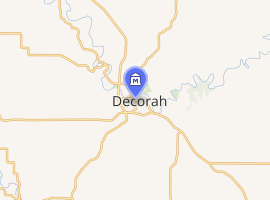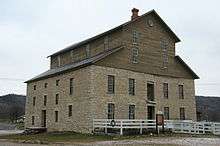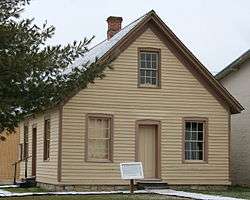Vesterheim Norwegian-American Museum
Vesterheim Norwegian-American Museum in Decorah, Iowa is the national Norwegian-American museum and heritage center, with over 33,000 artifacts, 12 historic buildings, a Folk Art School, and a library and archives. This treasure showcases the most extensive collection of Norwegian- American artifacts in the world. Some of its buildings are on the National Register of Historic Places. Vesterheim’s exhibitions explore the diversity of American immigration through the lens of the Norwegian-American experience and highlight the best in historic and contemporary Norwegian folk and fine arts.

| |
| Location | 502 West Water Street Decorah, Iowa, United States |
|---|---|
| Director | Chris Johnson |
| Website | http://vesterheim.org/ |
History
Vesterheim Museum was founded in 1877 as the Norwegian-American Historic Museum. It began as a part of nearby Luther College. In 1967, the Norwegian-American Museum incorporated, becoming a separate entity from Luther College. In 1977 it added Vesterheim to its name.[1] The museum moved into a larger location, a grand Italianate building in downtown Decorah vacated by a publishing company.[2]
The name Vesterheim appropriately translates to "western home" in Norwegian. The museum now offers educational events, publications, and lectures related to its mission. Vesterheim's Folk Art School offers classes in painting, woodworking, knifemaking, fiber arts, Nordic cooking, and more in the Norwegian tradition. Each year it presents "The National Norwegian-American Folk Art Exhibition" in these traditional Norwegian folk arts: knitting, rosemaling, weaving, woodcarving, knifemaking, and metalworking.
Heritage Park
Heritage Park is a collection of historic buildings located behind the museum's main building.
Painter-Bernatz Mill

The Painter-Bernatz Mill is at 200 North Mill Street, in Heritage Park. It was listed on the National Register of Historic Places in 1974. The Old Stone Mill was built by William Painter, one of Winneshiek County's earliest European settlers, in 1851 and is commonly believed to be the oldest building in Decorah.[3]
Norris Miller House

The Norris Miller House is at 118 North Mill Street, in Heritage Park. Norris Miller, a carpenter from Ohio, built this house in west Decorah in 1856. It was listed on the National Register of Historic Places in 1976.
Haugan House
Norwegian immigrants Hans and Anna Haugan built the house on a farm southeast of Decorah during the 1860s and lived in it at least until 1880. The house is a representative example of the husmann dwelling (Norwegian: hytte) used in Norway during the 19th Century. Husmann is the name for the Norwegian tenant farmer with leasehold estate somewhat similar to the Swedish torp or the Scottish crofter.[4] The husmann formed a key element of the Norwegian farm culture. The house used by typical husmann was often a simple log cabin or cottage made of rough hewed lumber.[5]
Valdres House
This represents a typical Norwegian landowner’s home. The Valdres House was built about 1795 on the Moahaugen farm in Heggenes, Øystre Slidre in Oppland, Norway. The house was enlarged and a covered entry added in the 1860s. Vesterheim acquired the house through the efforts of the rosemaler Sigmund Aarseth and of Kolbein Dahle, director of the Valdres Folk Museum in Fagernes, in the valley of Valdres, Norway. The house was taken down and shipped to Vesterheim in 1975-76. The house was reassembled by Norwegian carpenters commissioned by the Valdres Folk Museum.
Egge-Koren House
Erik Egge built this house in 1852 on his farm five miles southeast of Decorah. In July 1853, he married Helen Pedersdatter, a widow with two small children. From December 1853 to March 1854, the newlyweds, Rev. U. Vilhelm Koren and his wife Elisabeth, lived with the Egges. Ulrik Vilhelm Koren was a pioneer Lutheran minister, who played a significant role in the development of the spiritual and intellectual development of Norwegians in America. Koren played an active part in the Synod of the Norwegian Evangelical Lutheran Church in America, holding various including president of the synod from 1894 until his death in 1910. Elisabeth Koren was an author of The Diary of Elisabeth Koren, 1853-1855 which provides detailed insight into what it was like for four adults and two children to spend the winter in a one-room 14-by-16-foot log house.[6]
References
- Vesterheim Museum and Library Chronicles Lives of Norwegian Immigrants (Vesterheim Museum and Library)
- Xenakis, Alexis (Summer 2001). "Vesterheim, Home to the Norwegian American Experience—and Knitting". Knitter's Magazine. 18 (2): 18–19.
- The Old Stone Mill in Decorah, Iowa (Vesterheim Norwegian-American Museum)
- Haugen, Einar (1965) Norwegian English Dictionary (University of Wisconsin Press. Madison, Wisconsin).
- Hassing, Arne Norway’s Organized Response to Emigration (The Norwegian-American Historical Association. Volume 25: page 54).
- The Diary of Elisabeth Koren, 1853-1855 (Koren, Elizabeth. New York : Arno Press, 1979, ©1955)